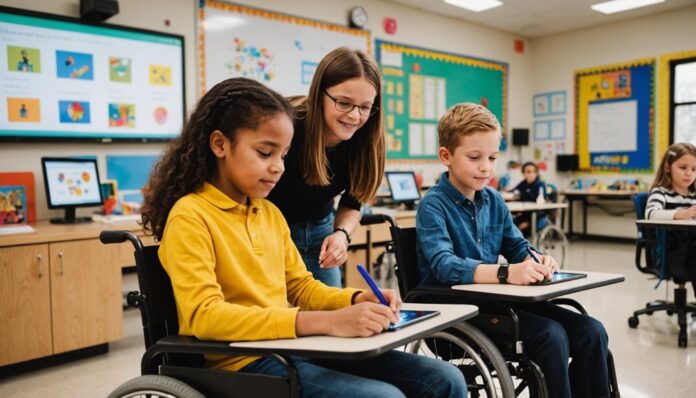Schools are utilizing the power of technology to create inclusive learning environments. By implementing adaptive assessments and assistive devices, educators can cater to diverse student needs. Text-to-speech software and customizable learning platforms enable students with disabilities to access information and engage in classroom activities. As schools continue to break down barriers, it becomes clear that technology is playing a crucial role in shaping the future of inclusive education, but what does this mean for students and educators alike?
Highlights
- Schools use adaptive assessments to adjust difficulty and content, providing targeted support and inclusivity for students with diverse abilities.
- Technology creates personalized learning experiences tailored to individual student needs, promoting engagement and motivation.
- Assistive technology, such as text-to-speech software and adaptive keyboards, helps students with disabilities overcome obstacles and access information.
- Digital tools, including virtual reality and sensory tools, create immersive learning environments that engage students with varying learning styles and abilities.
- Schools prioritize digital equity by allocating resources to device distribution, internet access, and accessible educational content to bridge educational disparities.
Making Learning Accessible for All Students
While technology has become an integral part of modern classrooms, its true potential lies in making learning accessible to all students, regardless of their abilities or disabilities.
One way technology achieves this is through adaptive assessments that adjust their level of difficulty and content in real-time based on a student’s performance. This allows teachers to identify areas where students need extra support and provide targeted interventions.
Additionally, collaborative tools enable students to work together on projects and share ideas, promoting inclusivity and social learning. Such tools also facilitate communication between teachers, students, and parents, helping to guarantee that everyone is on the same page.
This results in a more supportive and inclusive learning environment.
Using Technology to Personalize Learning Experiences
Building on the concept of making learning accessible, technology can also be employed to create personalized learning experiences that cater to the unique needs and abilities of each student.
Adaptive assessments, for instance, can gauge a student’s knowledge and skills, providing teachers with significant perspectives to tailor instruction. Individualized feedback is another key aspect, enabling students to track their progress and make adjustments as needed.
By leveraging technology, educators can develop customized learning plans that address the diverse needs of their students. This not only nurtures a more inclusive learning environment but also enables students to take ownership of their educational path.
As a result, students are more likely to stay engaged and motivated, leading to improved academic outcomes.
Breaking Down Barriers With Assistive Technology
Numerous students face considerable obstacles in traditional learning environments due to physical, cognitive, or sensory disabilities. To address these challenges, schools are leveraging assistive technology to break down barriers and create more inclusive learning experiences.
Assistive devices, such as text-to-speech software, speech-generating devices, and adaptive keyboards, enable students with disabilities to access information, communicate, and participate fully in class. Additionally, many digital tools and platforms now incorporate accessibility features, such as closed captions, screen reader compatibility, and adjustable font sizes, to guarantee equal access for all students.
Creating Immersive and Inclusive Learning Environments
Beyond the individual accommodations provided by assistive technology, schools are also utilizing the power of digital tools to create immersive and inclusive learning environments that benefit all students.
Virtual reality, for example, is being used to transport students to new and unexplored worlds, revolutionizing the way they learn and interact with complex concepts.
Additionally, sensory tools are being incorporated into classrooms to engage students with varying learning styles and abilities.
These digital tools provide a platform for students to participate and contribute equally, regardless of their abilities, creating a sense of belonging and inclusivity.
Ensuring Equitable Access to Educational Resources and Opportunities
While technology has the potential to bridge the gap in educational disparities, guaranteeing equitable access to educational resources and opportunities remains a pressing concern for schools.
To promote digital equity, schools must prioritize resource allocation, distributing devices, internet access, and digital tools to all students, regardless of socio-economic background or geographical location. This can be achieved through programs such as 1:1 device initiatives, public Wi-Fi installations, and partnerships with local organizations.
Additionally, schools can invest in digital platforms that offer accessible and inclusive educational content, including e-books, online courses, and multimedia resources.
Conclusion
Technology has become an essential tool in nurturing inclusion in schools. By providing accessible learning platforms, assistive devices, and immersive experiences, educators can cater to diverse student needs and promote social learning. As schools continue to utilize technology to break down barriers, they create a supportive environment where every learner can thrive. Ultimately, the strategic integration of technology guarantees that all students have equitable access to educational resources and opportunities.


